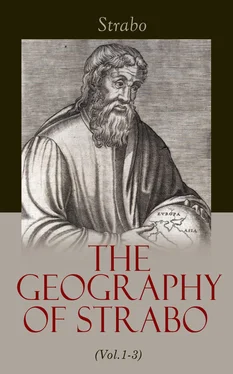Strabo - The Geography of Strabo (Vol.1-3)
Здесь есть возможность читать онлайн «Strabo - The Geography of Strabo (Vol.1-3)» — ознакомительный отрывок электронной книги совершенно бесплатно, а после прочтения отрывка купить полную версию. В некоторых случаях можно слушать аудио, скачать через торрент в формате fb2 и присутствует краткое содержание. Жанр: unrecognised, на английском языке. Описание произведения, (предисловие) а так же отзывы посетителей доступны на портале библиотеки ЛибКат.
- Название:The Geography of Strabo (Vol.1-3)
- Автор:
- Жанр:
- Год:неизвестен
- ISBN:нет данных
- Рейтинг книги:3 / 5. Голосов: 1
-
Избранное:Добавить в избранное
- Отзывы:
-
Ваша оценка:
- 60
- 1
- 2
- 3
- 4
- 5
The Geography of Strabo (Vol.1-3): краткое содержание, описание и аннотация
Предлагаем к чтению аннотацию, описание, краткое содержание или предисловие (зависит от того, что написал сам автор книги «The Geography of Strabo (Vol.1-3)»). Если вы не нашли необходимую информацию о книге — напишите в комментариях, мы постараемся отыскать её.
The Geography of Strabo (Vol.1-3) — читать онлайн ознакомительный отрывок
Ниже представлен текст книги, разбитый по страницам. Система сохранения места последней прочитанной страницы, позволяет с удобством читать онлайн бесплатно книгу «The Geography of Strabo (Vol.1-3)», без необходимости каждый раз заново искать на чём Вы остановились. Поставьте закладку, и сможете в любой момент перейти на страницу, на которой закончили чтение.
Интервал:
Закладка:
12. But the system of Hipparchus altogether teems with difficulties. Reflect for an instant on the following absurdity; after admitting that the southern extremity of India is under the same degree of latitude as Meroe, and that the distance from Meroe to the Strait of Byzantium is about 18,000 497stadia, he then makes the distance from the southern extremity of India to the mountains 30,000 stadia. Since Byzantium and Marseilles are under the same parallel of latitude, as Hipparchus tells us they are, on the authority of Pytheas, and since Byzantium and the Dnieper 498have also the same meridian, as Hipparchus equally assures us, if we take his assertion that there is a distance of 3700 499stadia between Byzantium and the Dnieper, there will of course be a like difference between the latitude of Marseilles and the Dnieper. This would make the latitude of the Dnieper identical with that of Keltica next the Ocean; for on proceeding 3700 stadia [north of Marseilles], we reach the ocean. 500
13. Again, we know that the Cinnamon Country is the most southerly point of the habitable earth. According to Hipparchus’s own statement, the latitude of this country, which marks the commencement of the temperate zone, and likewise of the habitable earth, is distant from the equator about 8800 stadia. 501And since he likewise says that from the equator to the parallel of the Dnieper there are 34,000 stadia, there will remain a distance of 25,200 stadia between the parallel of the Dnieper (which is the same as that which passes over the side of Keltica next the Ocean) to that which separates the torrid from the temperate zone. It is said that the farthest voyages now made north of Keltica are to Ierne, 502which lies beyond Britain, and, on account of its extreme cold, barely sustains life; beyond this it is thought to be uninhabitable. Now the distance between Keltica and Ierne is estimated at not more than 5000 stadia; so that on this view they must have estimated the whole breadth of the habitable earth at 30,000 stadia, or just above.
14. Let us then transport ourselves to the land opposite the Cinnamon Country, and lying to the east under the same parallel of latitude; we shall there find the country named Taprobane. 503This Taprobane is universally believed to be a large island situated in the high seas, and lying to the south opposite India. Its length in the direction of Ethiopia is above 5000 stadia, as they say. There are brought from thence to the Indian markets, ivory, tortoise-shells, and other wares in large quantities. Now if this island is broad in proportion to its length, we cannot suppose that the whole distance, 504inclusive of the space which separates it from India, is less than 3000 stadia, which is equal to the distance of the [southern] extremity of the habitable earth from Meroe, since the [southern] extremities of India and Meroe are under the same parallel. It is likely there are more than 3000 stadia, 505but taking this number, if we add thereto the 30,000 stadia, which Deimachus states there are between [the southern extremity of India] and the country of the Bactrians and Sogdians, we shall find both of these nations lie beyond the temperate zone and habitable earth. 506Who will venture to affirm such to be the case, hearing, as they must, the statement made both by ancients and moderns of the genial climate and fertility of northern India, Hyrcania, Aria, Margiana, 507and Bactriana also? These countries are all equally close to the northern side of the Taurus, Bactriana being contiguous to that part of the chain 508which forms the boundary of India. A country blessed with such advantages must be very far from uninhabitable. It is said that in Hyrcania each vine produces a metrete 509of wine, and each fig tree 60 medimni 510of fruit. That the grains of wheat which fall from the husk on to the earth spring up the year following; that bee-hives are in the trees, and the leaves flow with honey. The same may be met with in the part of Media called Matiana, 511and also in Sacasena and Araxena, countries of Armenia. In these three it is not so much to be wondered at, since they lie more to the south than Hyrcania, and surpass the rest of the country in the beauty of their climate; but in Hyrcania it is more remarkable. It is said that in Margiana you may frequently meet with a vine whose stock would require two men with outstretched arms to clasp it, and clusters of grapes two cubits long. Aria is described as similarly fertile, the wine being still richer, and keeping perfectly for three generations in unpitched casks. Bactriana, which adjoins Aria, abounds in the same productions, if we except olives.
15. That there are cold regions in the high and mountainous parts of these countries is not to be wondered at; since in the [more] southern climates the mountains, and even the tablelands, are cold. The districts next the Euxine, in Cappadocia, are much farther north than those adjoining the Taurus. Bagadania, a vast plain, situated between the mountains of Argæus 512and Taurus, hardly produces any fruit trees, although south of the Euxine Sea by 3000 stadia; while the territory round Sinope, 513Amisus, 514and Phanarœa abounds in olives.
The Oxus, 515which divides Bactriana from Sogdiana, is said to be of such easy navigation that the wares of India are brought up it into the sea of Hyrcania, 516and thence successively by various other rivers to the districts near the Euxine. 517
16. Can one find any fertility to compare with this near to the Dnieper, or that part of Keltica next the ocean, 518where the vine either does not grow at all, or attains no maturity. 519However, in the more southerly portions of these districts, 520close to the sea, and those next the Bosphorus, 521the vine brings its fruit to maturity, although the grapes are exceedingly small, and the vines are covered up all the winter. And in the parts near the mouth of the Palus Mæotis, the frost is so strong that a general of Mithridates defeated the barbarians here in a cavalry engagement during the winter, and on the very same spot in a naval fight in summer, when the ice was thawed. Eratosthenes furnishes us with the following inscription, which he found in the temple of Æsculapius at Panticapæeon, 522on a brazen vase which had been broken by the frost:—
“If any one doubts the intensity of our winter’s cold, let him believe when he sees this vase. The priest Stratius placed it here, not because he considered it a worthy offering to the god, but as a proof of the severity of our winter.”
Since therefore the provinces we have just enumerated [are so superior in climate, that they] cannot be compared with the countries surrounding the Bosphorus, nor even the regions of Amisus and Sinope, (for every one will admit that they are much superior to these latter,) it would be idle to compare them with the districts near the Borysthenes and the north of Keltica; for we have shown that their temperature is not so low as Amisus, Sinope, Byzantium, and Marseilles, which are universally acknowledged to be 3700 stadia south of the Dnieper and Keltica.
17. If the followers of Deimachus add to the 30,000 stadia the distance to Taprobane and the boundaries of the torrid zone, which cannot be reckoned less than 4000 stadia, 523they will then remove Bactria and Aria from their actual localities and place them 34,000 stadia from the torrid zone, a distance equal to that which Hipparchus states to be between the equator and [the mouth of] the Dnieper, and the two countries will therefore be removed 8800 stadia north of [the mouth of] the Dnieper and Keltica; for there are reckoned to be 8800 stadia from the equator to the parallel of latitude which separates the temperate from the torrid zone and which crosses the Cinnamon Country. 524We have proved that the regions not more than 5000 stadia north of Keltica, as far as Ierne, 525are scarcely habitable, but their reasoning leads to the conclusion that there is another circle fitted for the habitation of man, although 3800 stadia north of Ierne. 526And that Bactra is still farther north than the mouth of the Caspian or Hyrcanian Sea, which is distant about 6000 stadia from the recess of the Caspian and the mountains of Armenia and Media, and which appears to be the most northerly point of the whole coast as far as India, with a sea navigable to India all the way, as Patrocles, who had the government of these regions, affirms. Now Bactriana stretches 1000 stadia farther north. Beyond this the Scythians occupy a much larger territory, bounded by the Northern Ocean: here they dwell, though to be sure theirs is a nomade life. But we ask how they could exist here at all, supposing even Bactra to be beyond the limits of the habitable globe. The distance from the Caucasus to the Northern Sea through Bactra would be rather more than 4000 stadia. 527This being added to the number 528of stadia north of Ierne 529above-mentioned, will give us the whole amount of uninhabitable land from Ierne northward 7800 stadia, and even omitting the 4000 stadia altogether, those parts of Bactriana next the Caucasus will still be 3800 stadia farther north than Ierne, and 8800 farther north than Keltica, 530and [the mouth] of the Dnieper.
Читать дальшеИнтервал:
Закладка:
Похожие книги на «The Geography of Strabo (Vol.1-3)»
Представляем Вашему вниманию похожие книги на «The Geography of Strabo (Vol.1-3)» списком для выбора. Мы отобрали схожую по названию и смыслу литературу в надежде предоставить читателям больше вариантов отыскать новые, интересные, ещё непрочитанные произведения.
Обсуждение, отзывы о книге «The Geography of Strabo (Vol.1-3)» и просто собственные мнения читателей. Оставьте ваши комментарии, напишите, что Вы думаете о произведении, его смысле или главных героях. Укажите что конкретно понравилось, а что нет, и почему Вы так считаете.












![Anne Blunt - A Pilgrimage to Nejd, the Cradle of the Arab Race. Vol. 2 [of 2]](/books/750183/anne-blunt-a-pilgrimage-to-nejd-the-cradle-of-the-thumb.webp)